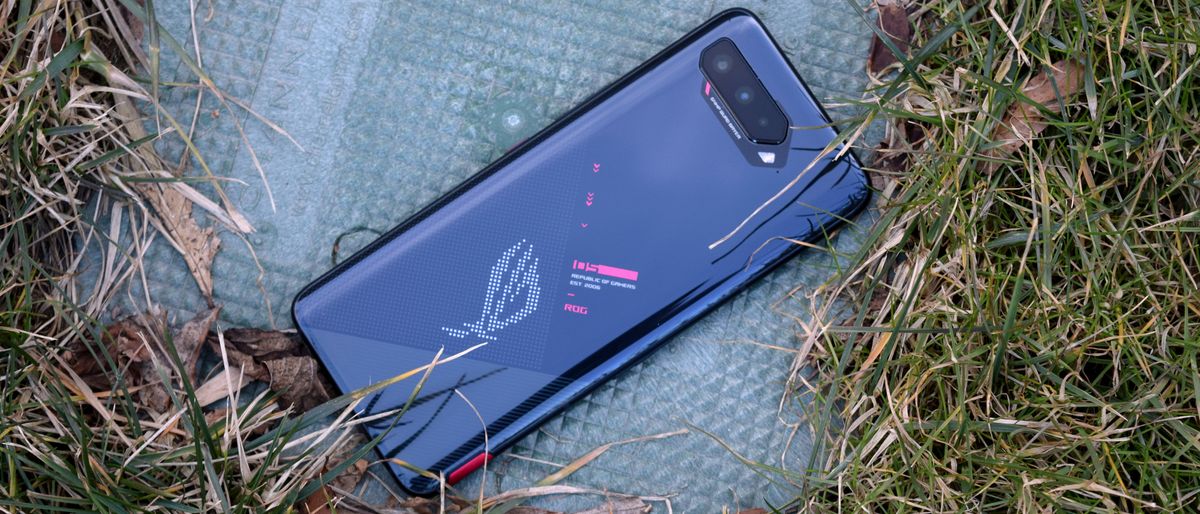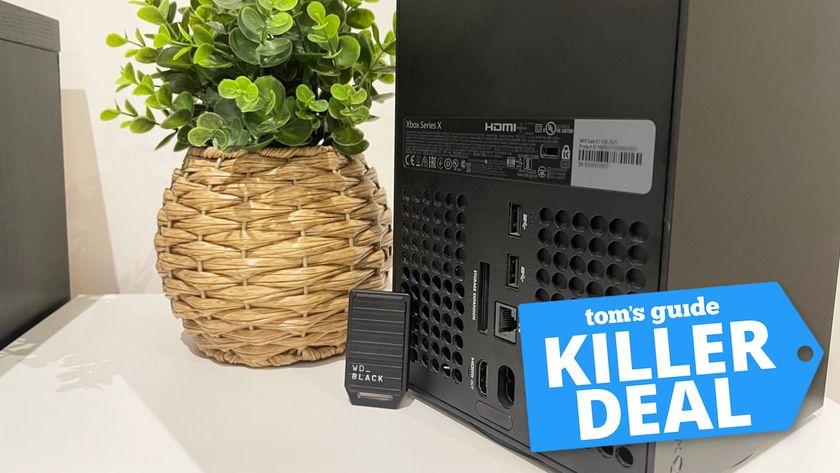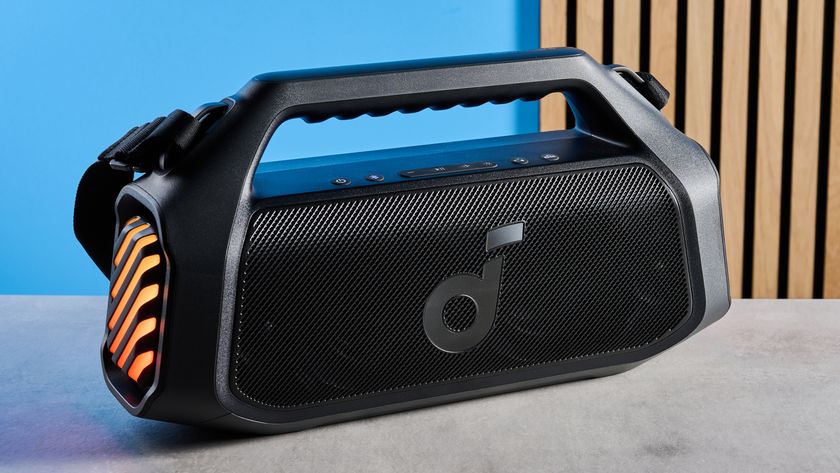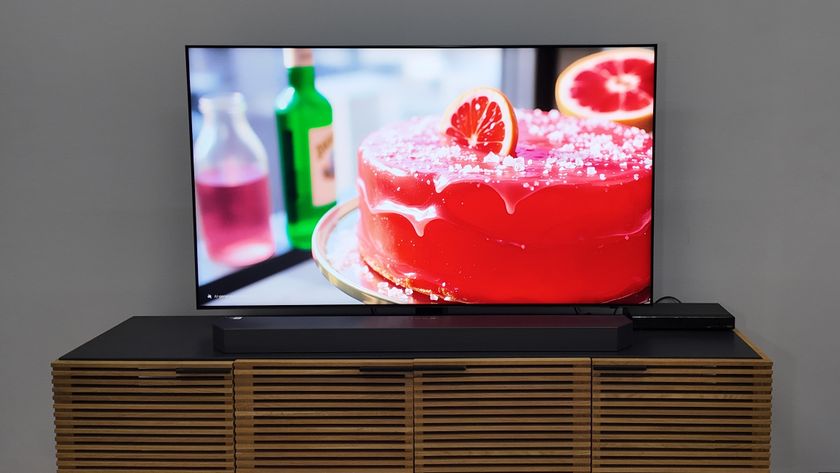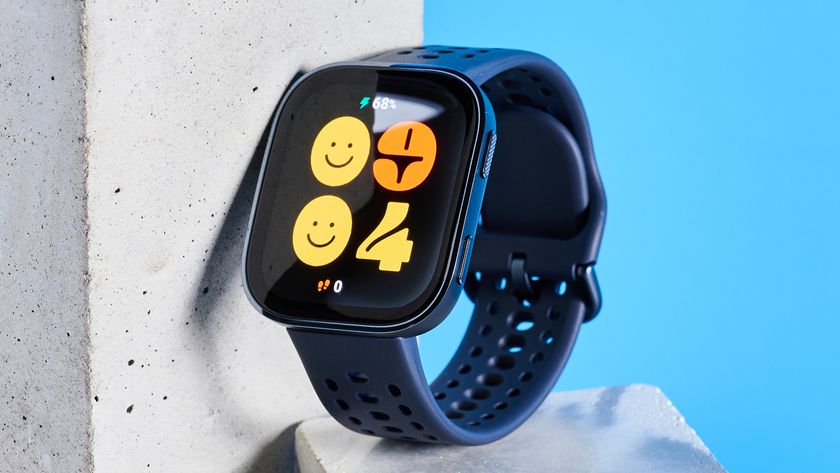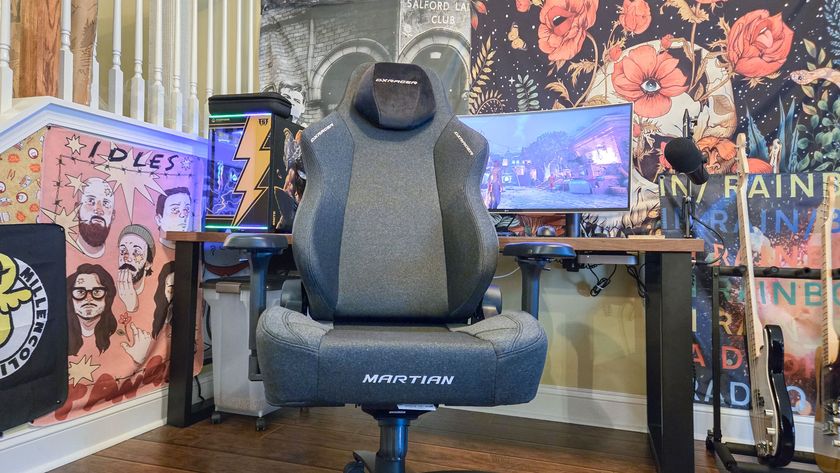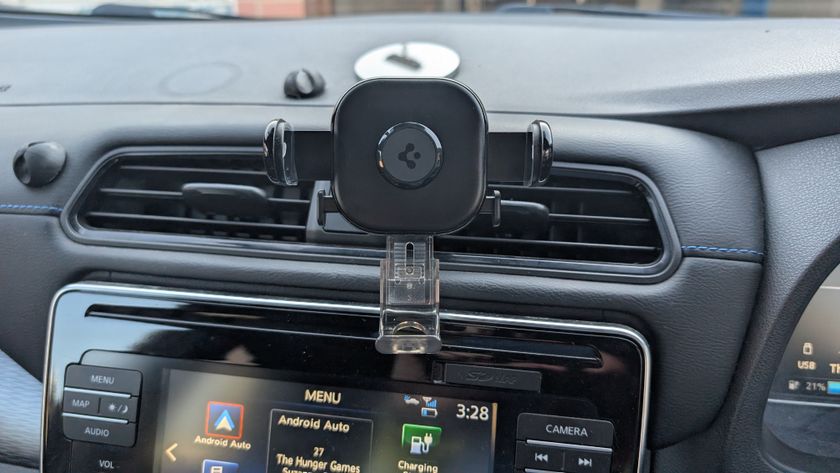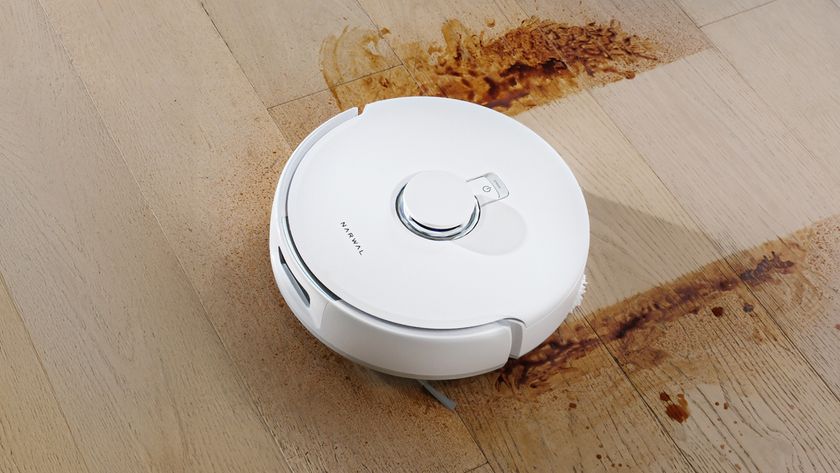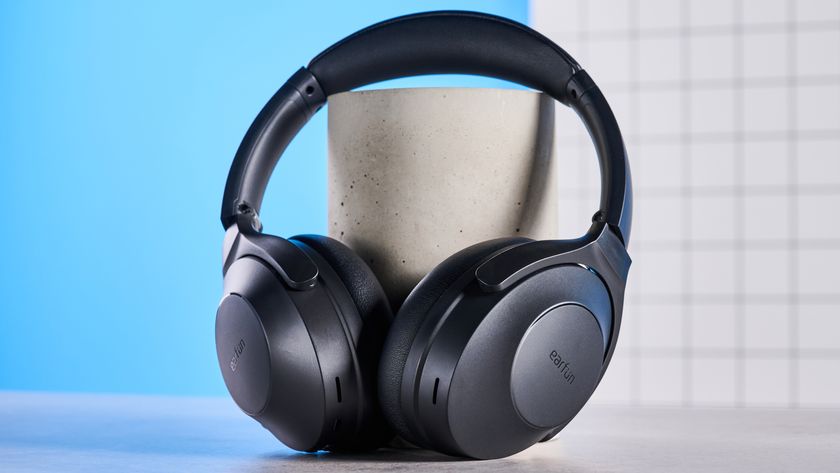Tom's Guide Verdict
The ROG Phone 5 is a powerful device and an excellent gaming machine, but abysmal camera performance holds it back from being a good all-around phone.
Pros
- +
Superb performance
- +
Beautiful AMOLED display with 144Hz refresh rate
- +
Excellent battery life
- +
Powerful front-facing speakers
Cons
- -
Disappointing night mode
- -
Bulky and heavy
- -
“Gamer” aesthetic not for everyone
- -
No wireless charging
Why you can trust Tom's Guide
OS: Android 11 / ZenUI
Screen size: 6.78-inch AMOLED (2448 x 1080); 60 - 144Hz
Processor: Snapdragon 888
RAM: 8GB, 12GB, 16GB
Storage: 128GB, 256GB
Rear cameras: 64MP ultrawide (f/1.8), 13MP ultrawide (f/2.4), 5MP macro (f/2.0)
Front camera: 24MP (f/2.45)
Video: Up to 8K at 30 fps
Battery: 6,000 mAh
Battery life (Hrs:Mins): 12:23 (60Hz) / 10:53 (120Hz) / 10:27 (144Hz)
Charging: 65W
Colors: Phantom Black, Storm White
Size: 6.1 x 2.7 x 0.36 inches
Weight: 8.39 ounces
The ROG Phone 5 hasn't helped my skepticism regarding dedicated "gaming phones." After all, since these devices use the same system on chip as the other best Android phones, what advantages could they possibly offer over a regular handset? The improvements seemed marginal, at least to me.
But gaming phones have thrived, in part by pushing features like fast-refreshing displays to the mainstream. And so Asus is back with a new generation of its ROG phone, which will be available in three different variations.
That brings us to the crown king of gaming phones, the Asus ROG Phone 5, the fourth generation gaming phone under the Taiwanese company’s Republic of Gamers brand. Asus has made three versions of this device — the base model, the ROG Phone 5 Pro, and a limited Ultimate edition.
Regardless of which version you opt for, our Asus ROG Phone 5 review finds a device jammed pack with hardware and software designed to give you the best gaming experience. It's in the other smartphone features where the ROG Phone 5 comes up short, however.
Editor's note: We crowned our picks in the Tom's Guide Awards 2021 for phones. The ROG Phone 5 won two highly recommended awards.
Asus ROG Phone 5 review cheat sheet
- The ROG Phone 5 uses a custom 6.78-inch FHD+ AMOLED display made by Samsung. It’s bright, colorful, and perfectly tailored for gaming.
- The ROG Phone 5 produced the best benchmark results of any Android phone we’ve tested. it managed a 3,673 multicore score in Geekbench 5 and 34.8 FPS in Wild Life Unlimited.
- The ROG Phone 5’s huge 6,000 mAh battery lasts for an incredibly long time, even when gaming. With its 65W charger, you can recharge the phone in less than an hour.
- The biggest problem with the ROG Phone 5 is the poor camera performance. Photos look lifeless and dull, and they lack depth. Night mode is a travesty.
- Sound is a major plus for the ROG Phone 5, including incredible front-facing speakers and a headphone jack tied to a quad DAC.
Asus ROG Phone 5 review: Release date and price
The Asus ROG 5 is now available in the U.S. having initially launched into the U.K. and Europe. However, only the standard $999 model is available, with the top-end Ultimate handset still missing from American soil.
For residents of the U.K. and Europe, the base ROG Phone 5 with 8GB of RAM and 128GB of storage is available for €799/£799. You can upgrade the RAM to 12GB and storage for 256GB for another €100/£100. For yet another €100/£100, you can get 16GB of RAM and 256GB of storage.
The base model ROG Phone 5, which we’re reviewing here, comes in two colors: Phantom Black and Storm White. Both units feature the RGB dot matrix ROG logo on the back for that added flair.
Though not included in this review, there is also a ROG Phone 5 Pro with 16GB of RAM and 512GB of storage for €1199. It comes out in April. Instead of the dot matrix logo on the phone’s back, you get a PMOLED color display that Asus calls ROG Vision. It’s customizable in the Armoury Crate app, where you can decide what moving image you want to display.
Finally, there’s also the ROG Phone 5 Ultimate, a celebration of the ROG brand and gamers everywhere. It not only features a unique monochrome body and with a monochrome PMOLED ROG Vision, but it comes with 512GB of storage and a whopping 18GB of RAM. This is a limited edition phone that you can get for €1299, available in May. We have a separate ROG Phone 5 Ultimate review if you’d like to check that out.
Asus ROG Phone 5 review: Design
The whole look of the black base model ROG Phone 5 screams edgy for edginess’ sake. It falls into the "gamer" aesthetic and it won't be for everyone. And this is coming from someone who uses a ROG Crosshair motherboard and Strix 2080 Ti in his gaming PC.
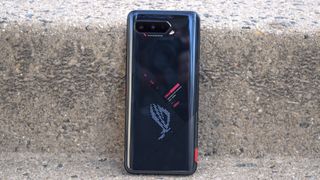
One could hope that people have outgrown the need for sharp accents, huge logos, and RGB to prove they’re worthy of the title of “gamer,” especially on a phone. Alas, Asus has gone all out with the ROG Phone 5’s design. It won’t be for everyone, even those who spend a lot of time playing video games.
I have large hands and the 6.1 x 2.7 x 0.36-inch ROG Phone 5 still feels bulky and unwieldy, but that’s the cost of the huge 6,000 mAh battery inside it. The 6.78-inch display takes up the front of the phone with minimal bezels all around. There’s no hole punch or notch for the front camera, which is nestled in the top bezel.
The ROG Phone 5 features an optical fingerprint sensor built into the display. The feature works OK, though I had trouble with accuracy and false negatives multiple times a day. The in-display sensor on the Galaxy S21 Plus behaves far more consistently.
Tucked away at the very edges of the top and bottom bezels are the front-facing stereo speakers, which are some of the best speakers I’ve heard on a phone. They’re punchy, they’re powerful, and they’ll wow you with their depth. But there’s also a headphone jack with a quad ESS DAC, so you can have an even better audio experience with the ROG Phone 5. I really appreciated this inclusion.
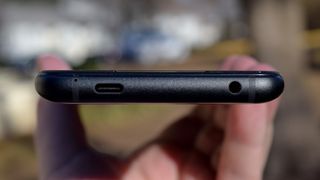
One of the weirdest things about the ROG Phone 5 is where Asus placed the phone’s ports. The power USB-C port is on the left side underneath a removable (and easily-losable) cover. Alongside it is the POGO connector for the optional AeroActive cooler accessory, which clips onto the phone. The cooler accessory is a basically a small fan that attaches to the back of the phone and assists with cooling. The ROG logo on the back of it glows and there’s a substantial kickstand if you want to prop the phone up. A second USB-C port lives on the bottom of the frame, but that is used for the Kunai 3 Gamepad.
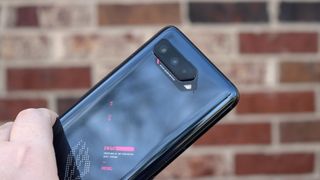
Besides the cooler accessory, the ROG Phone 5 employs AirTriggers to boost the gaming experience. These ultrasonic shoulder buttons can be mapped to a specific action per game. They don’t work perfectly in every title, and in some cases they can be a hindrance, but it’s just one more thing to make the ROG Phone feel like a step above non-gaming phones.
The ROG Phone 5 is a big boy, make no mistake. It’s heavy, which leads to quicker wrist and finger fatigue (especially while gaming for long periods of time), but it’s also a solid device. Asus did an excellent job with this phone’s build quality, making it feel very premium.
Asus ROG Phone 5 review: Display
The star of the show is the 6.78-inch custom AMOLED display manufactured by Samsung. The ROG Phone 5 sports a beautiful screen, perfect for gaming. It’s huge, it has excellent color reproduction, and it gets plenty bright. I really enjoyed this display while I was using the ROG Phone 5.
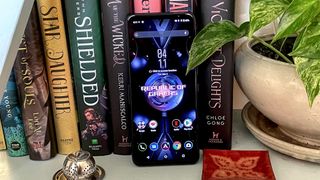
You also get four refresh rate modes to choose from: 60Hz, 120Hz, 144Hz, and Auto. The latter adaptively changes the refresh rate depending on what you’re doing. If you’re scrolling a lot or playing a game, the refresh rate will ramp up, scaling back down for more static activities. Obviously, 60Hz is the most battery-efficient refresh rate, but the 144Hz mode is available for games that support higher frame rates (like Dead Cells).
In its Natural color calibration, the ROG Phone 5 reproduced 180.2% of the sRGB and 127.6% of the DCI-P3 color gamuts. Its Delta-E score, where 0 is perfect, was 0.31. For comparison, in its Natural mode, the Galaxy S21 Plus managed 103.8% of sRGB and 73.5% of DCI-P3 with a Delta-E of 0.18. (Delta-E numbers closer to zero are more accurate.)
A top-tier gaming phone ought to have a display to match its high-end specs and the ROG Phone 5 delivers. It’s also plenty bright enough to see outdoors, even in direct sunlight, hitting 748 nits in our testing, which is inline with the Galaxy S21 Plus’ 747 nits.
Asus ROG Phone 5 review: Cameras
The ROG Phone 5 may be a gaming phone, but it still features cameras just like any other handset. You get a triple camera array on the back: a 64MP ultrawide main sensor joined by a 13MP ultrawide shooter, and a 5MP macro lens.
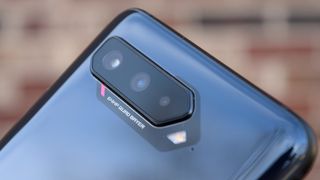
Those cameras turned in a disappointing performance. Compared to a comparably priced Galaxy S21 Plus, the photos I took with the Asus ROG Phone 5 didn't impress me. Asus usually does a good job with cameras and software, so this is a bit surprising.
In optimal lighting conditions outdoors, the ROG Phone 5 produces adequate shots with decent colors and depth. Compared to the Galaxy S21 Plus, which likes to overexpose and oversaturate, the ROG Phone 5’s picture feels a bit restrained. It’s not bad, though there’s something off about it.
In direct sunlight, the ROG Phone 5 started to stumble. The red of the fire hydrant looks a bit dim, almost toned down, in the ROG Phone’s shot. It’s a bit more vibrant in the S21 Plus’ photo, but both phones had a bit of trouble regulating themselves in the harsh sunlight. Overall, though, the Galaxy S21 Plus did a better job.
Moving indoors, both phones did well with the statuette of Merida. The colors of her hair and dress look nice in both images, even if the Galaxy S21 Plus’ looks a bit stronger in comparison. These pictures were taken in the late afternoon with soft ambient lighting, but I like how they both turned out.
Stepping outside for portraits, the ROG Phone 5 used a relatively mild blur radius in comparison to the Galaxy S21 Plus, but I look very overexposed in the shot. The S21 Plus manages to capture some of the redness in my skin, but its portrait isn’t a whole lot better than the ROG Phone 5’s.
Putting the ROG Phone 5 up against the Galaxy S21 Plus for night mode, you can immediately see the difference. It’s almost like the ROG Phone 5’s night mode didn’t even try, whereas the grill is actually visible in the S21 Plus’ photo.
For selfies, the ROG Phone 5 uses a 24MP front camera. It captured the yellow in my camera strap, but the whole photo looks a bit cool. The berries and bricks in the background are blurry, too. Overall, this selfie is not one I’d want to post or share anywhere. The S21 Plus made everything a bit green, but everything in the shot stayed in focus.
Asus ROG Phone 5 review: Performance
The ROG Phone 5 is sold on the fact that it’s the ultimate mobile gaming machine, replete with everything you need to see yourself succeed in your favorite games. While no amount of hardware will make up for a lack of skill or understanding, having the best internals you can possibly get doesn’t hurt.

The ROG Phone 5 uses the latest system-on-chip from Qualcomm, the Snapdragon 888, paired with 8GB, 12GB or 16GB of RAM, depending on which configuration you order. You will want for nothing as far as raw performance is concerned. The Snapdragon 888 still pales in comparison to the A14 Bionic from Apple, but it’s the best SoC you can get in an Android device right now.
This is the best Snapdragon 888 device we’ve tested thus far. In Geekbench 5, the ROG Phone 5 (with X-Mode disabled) scored 3,672 on multicore. That trounces the Galaxy S21 Plus’ 3,300 result, even if it comes up shy against the iPhone 12 Pro’s 3,880.
In 3DMark’s Wild Life Unlimited, the ROG Phone 5 scored 5,806 with an average fps of 34.8. That barely beats the S21 Plus’ 33.4 average fps, but falls behind the iPhone 12 Pro’s 39 fps average.
Anecdotally, this phone is a monster in games, but even it struggles with a title like Genshin Impact on max settings. I saw frame rates bouncing between 17 and 45 just in the main hub area without fighting or anything. In Call of Duty: Mobile, my other favorite mobile game, the ROG Phone 5 was a champ. I saw consistent frame rates, accurate touch response, and plenty of battery life to keep me playing for countless matches (most of which I dominated, I might add).
With the right profile selected (more on that later), Asus’ phone gives you its all and then some in games. It’s too bad that all this power feels relatively wasted on what’s available in Google Play right now, but that’s more a commentary on mobile gaming rather than anything against the ROG Phone 5.
Asus ROG Phone 5 review: Battery life and charging
The ROG Phone 5 comes with a total battery capacity of 6,000 mAh, split into two 3,000 mAh power packs. This allows for the simultaneous 65W charging speed and for Asus to use a PCB with the Snapdragon 888 in the middle (for heat purposes). These big batteries contribute to the phone’s overall size, but it’s all worth it given how long the ROG Phone 5 can last on a charge.
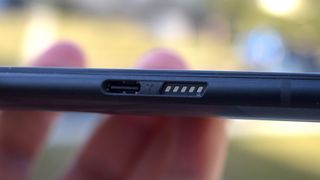
In our battery life test, where the phone is left to endlessly reload webpages over a cellular connection at 150 nits of screen brightness, the ROG Phone 5 performed extremely well. In 60Hz mode, the ROG Phone 5 managed a whopping 12 hours and 23 minutes. In 120Hz mode, that drops to a still impressive 10 hours and 53 minutes. Finally, ramping the display up to 144Hz nets 10 hours and 27 minutes.
In real-world use, the ROG Phone 5 is a battery-life champ. Outside of gaming, I was able to get more than two days of use before having to charge again. When gaming, the battery can last for a long time, too, even when playing Genshin Impact in 144Hz mode with the AeroActive cooler and Kunai 3 Gamepad attached.
Asus claims that the ROG Phone 5 can charge from 0% to 70% in just 30 minutes on the 65W charger and to full in about an hour. Charging a 6,000 mAh battery from empty to full is a large task, so that’s an impressive number. In 30 minutes, the ROG Phone went from 0% to 70% on its 65W charger. It reached 44% in 15 minutes.
To make sure that the batteries last long in terms of lifespan, Asus has introduced a few charging modes. The Steady charging mode slows down the charging speed, so the battery will take longer to fill up, but it’ll also generate less heat. Scheduled charging is what it sounds like and can work with active alarms (i.e. the phone stops charging when your morning alarm goes off). You can also set an upper charging limit of 80%, 90%, and 100% to extend the battery’s lifespan. Finally, you can go with Bypass charging, which uses the power cable to provide power to the phone without charging the battery itself.
Asus ROG Phone 5 review: Software and special features
With the ZenFone 6, Asus changed its mobile software direction and introduced a minimal, stock-like Android experience like you might find on Pixels or OnePlus devices. There were several additional features tucked away in the Settings, but the new ZenUI offered users an unhindered software experience. That has continued somewhat with the ROG Phone 5.
ZenUI looks much the same as before, but there are multiple ROG “enhancements” on offer, which look a lot like Asus’ ROG Windows software, for better or for worse. I’ll give the company credit for consistency. I’d say 90% of the ZenUI experience, based on Android 11, is nice, minimal, and mostly good.

Asus wants the gaming tweaks and additions to add meaningful value. By dragging in from the edge of the screen while in-game, you get a feature-packed control panel called Game Genie. This offers shortcuts for optimizing the system for peak gameplay, turning off notifications, blocking navigation, setting refresh rates, and accessing the AirTrigger and macro settings. It also offers some quick stats like your average FPS, CPU temp, and clock speed.
I frankly forgot to use the Game Genie more often than not. Its aesthetic heavily contrasts with the relatively demure default ZenUI look. I think the shortcuts are nice, especially for setting up AirTriggers and macros, but I’d rather the design match the rest of the phone rather than some nebulous connection to the ROG PC stuff. The ROG software, called the Armoury Crate, in general is full of flashy colors and boisterous, “futuristic” sounds.
Like its PC brethren, the ROG Phone 5 has different profiles for different purposes. Spearheading these is called X-Mode, which is what Asus considers to be the best for gaming. Simply put, X-Mode maximizes performance. There’s also Dynamic, which is my preferred profile — it adjusts to your use and needs accordingly. The Ultra durable profile aims to maximize battery life, while a custom mode lets you tweak settings like you might for your motherboard. You can get into some really nitty gritty details here.

The ROG Phone 5 comes with an RGB dot matrix display on the back of the phone, the colors of which can be customized in the Armoury Crate. You can set the secondary display to react to notifications, games, and some other options. I don’t think it’s really necessary, but it definitely makes the phone stand out.
Asus ROG Phone 5 review: Verdict
If you’re looking for ultimate mobile gaming performance, the ROG Phone 5 is definitely at the top of the list. Its gargantuan battery lasts an incredibly long time, the custom AMOLED display is gorgeous, and the raw power makes almost everything playable at 60 fps or above.
However, if taking good pictures matters to you, the ROG Phone 5 is just okay. Its night mode falls flat, however. The photos are by no means bad, but I prefer the ones produced by other similarly-priced phones like the Pixel 5, iPhone 12, and Galaxy S21 Plus.
Buy the ROG Phone 5 if you want a mammoth battery that’s incredibly difficult to kill or if you want the peak gaming performance available on Android. It's a true marvel of engineering to be sure. And you get some extra RGB and gamer flair for your money (if that's your thing), which helps the phone stand out from the crowd.

Jordan is the Phones Editor for Tom's Guide, covering all things phone-related. He's written about phones for over six years and plans to continue for a long while to come. He loves nothing more than relaxing in his home with a book, game, or his latest personal writing project. Jordan likes finding new things to dive into, from books and games to new mechanical keyboard switches and fun keycap sets. Outside of work, you can find him poring over open-source software and his studies.
